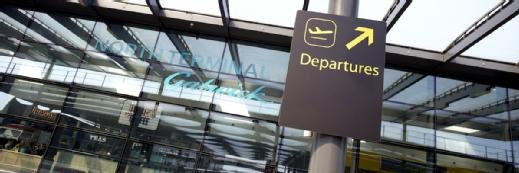
Fibre cable break takes Gatwick flight information screens offline
A broken fibre-optic cable has taken Gatwick Airport’s flight information screens offline, with airport staff forced to use whiteboards to provide information to passengers
A broken fibre cable belonging to network operator and services supplier Vodafone has caused problems for passengers departing from Gatwick Airport after causing flight information screens at the airport to shut down.
Pictures circulated on social media showed airport staff using whiteboards to display flight information, including gates and departure times, in the departure lounges, with travellers describing scenes of “utter chaos” and “absolute carnage”.
An official statement from Gatwick Airport on Twitter said: “Due to an ongoing issue with Vodafone – an IT provider for the airport – our flight information screens are not displaying correctly. Please use the temporary flight boards in the departure lounges or listen for airline flight announcements.
“We expect Vodafone to resolve the issue soon and would like to apologise to passengers for any inconvenience.”
A spokesperson for Gatwick said that while it was not ideal to be using whiteboards to convey information, the issue was not causing significant disruption for passengers, and that the so-called “first wave” of departures during the airport’s busy morning peak had taken off mostly on schedule, with minimal numbers of passengers missing flights.
A Vodafone spokesperson confirmed the supplier was working to fix the broken cable. “We have identified a damaged fibre cable which is used by Gatwick Airport to display flight information,” they said.
“Our engineers are working hard to fix the cable as quickly as possible. This is a top priority for us and we are very sorry for any problems caused by this issue. We are keeping Gatwick Airport constantly informed of progress.”
The cable break highlights the extent to which even the most digitally advanced organisations are ultimately reliant on fibre backhaul, and doubly so for Gatwick Airport, which recently completed a major overhaul of its networking capability, replacing its legacy infrastructure with a more resilient network sourced through Hewlett-Packard Enterprise and Aruba, its wireless network unit.
The airport is the busiest single-runway facility in the world, handling more than 44 million passengers per annum. Its new network architecture is a fully meshed design, providing 10 times the number of data links across its Sussex campus, using a backbone based on multiple 40Gbps connections to remove network bottlenecks and potential single points of failure.
Speaking to Computer Weekly earlier in 2018, Gatwick CIO Cathal Corcoran said the revitalised network would also enable him to introduce innovative new technology around the airport. The airport has already introduced augmented reality (AR) beacon technology to guide passengers through its terminals, and is currently conducting a trial of autonomous vehicle technology for use in shuttling staff – and potentially luggage and passengers – around the airport.
Read more about fibre backhaul
- O2, Three and Vodafone unite in calling for more to be done to open up dark fibre networks to supply desperately needed capacity for their future 5G networks.
- By layering Infinera technology over its existing network, SSE Enterprise Telecoms plans to deliver what it refers to as a “dark fibre-like” access product for communications services providers.
Read more on Telecoms networks and broadband communications
-
![]()
British Airways outage: Airline cancels weekend short-haul flights due to ‘technical issues’
-
![]()
Heathrow Airport takes to the cloud with Oracle Fusion Applications
-
![]()
Avinor creates contactless airport check-in for Norway
-
![]()
Airports deploy thermal cameras to control Covid-19, science suggests it’s merely ‘safety theatre’










